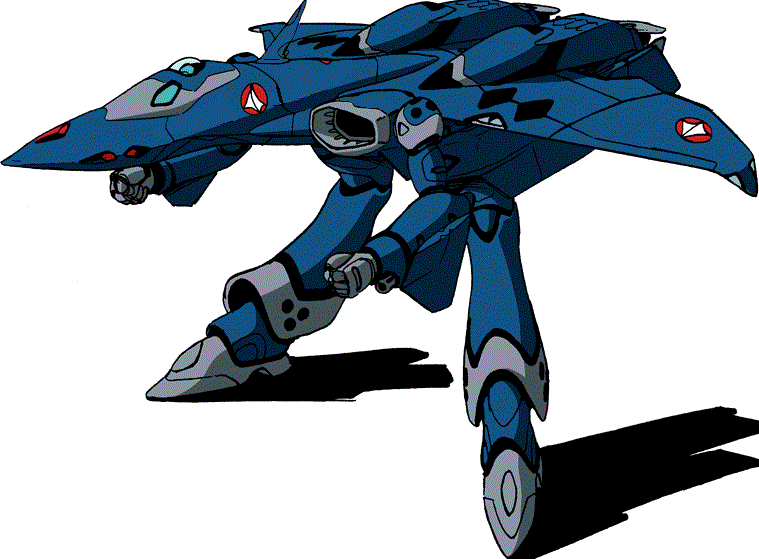
United Galaxies Council. | F/AG-36 Hornet II. | 
United Galaxies Council. |
|---|
 | An F/AG-36 Hornet II
In REF Marine Colors. |
|---|
The UGC was looking for the second generation of fighter attack Guardians to replace the older F/AG-8 Phantom III. Testing on a fixed-wing version of the VF-1 lead to the F/AG-36 Hornet II. Essentially, it is a VF-1 with VAF-6 Alpha wings, legs, and arms. The head laser was removed, and the old-fashioned Super Veritech Augmentation Pack integrated into the fuselage of the craft (unlike the Super Aggressor). The length of the craft necessitated the packs be lengthen by 10', which in turn allowed more fuel capacity in the simpler jet and rocket engines (rockets were selected as the main engines due to their space worthiness, while jet engines were installed in the legs until Dual Phase Aeration supplanted both). Additionally, the VF-1's tail assembly folded over in Guardian mode. While the Hornet's tailerons do fold down for atmospheric re-entry and storage, and can be folded down for combat, they are typically kept in an upright position. Charonina-7 Re-entry Kits were not installed on the original craft, and as such used heat tile applied shields that would be jettisoned for atmospheric entry. After Block 8, these kits were installed as standard (the process actually stared at about 3/4's of the way through Block 8, with retrofit kits shipped "with haste", making Block 9 the First to fully implement the kit but all Block 8 and earlier units in service were retrofitted before the change over).Another change over the F/AG-8 was the LACK of an integrated gun system; In the Phantoms, this weapon was installed before consideration was even made to the need, almost as if it was instinctive. However, the Hornet does NOT have such a weapon; Instead, it uses the GU-XX as its primary dog fighting/strafing tool. There have been intermittent calls to install L-02a or -08 rail launchers, but these ideas never get past proposal stages, and pilots themselves are divided on the issue.The F/AG-8 was originally built with a combination of PP-261 plasma rockets (fuselage) and JR821 jet thrusters (legs) for transatomspheric service; Though the theory of dual phase aeration was already posited, no workable solution had by this point been developed. After dual phase shutters were developed, the Hornet fleet was retrofitted in short order (Block 16 being the First to fully implement them at factory), with the plasmafied air being ducted out the feet via verniers, making them much more resilient to damage (no longer would this gaping opening be required) and reducing maintenance (since the secondary engines could now be removed entirely, while the ducting necessary to use the verniers required only minutes for routine maintenance, versus the hours required for the jets, and didn't have to be removed for major upkeep). The UGC Select Defense Appropriations Committee considered adding MM-50/60 missile launchers, but pilots (not ground crews nor bean counters) objected to them as "not particularly useful."An excellent day and night fighter/attack weapons platform, the F/AG-36 will remain in the UGC's inventories for years to come, despite the advent of the A/BG-20 Thunderbolt and the F/AG-44 Raptor. In point of fact it is the primary UGC aerospace fighter, being nearly as numerous as all others combined (though the F/A-18 Hornet and Spacer II Space Fighter for a time outnumbered them).Name: F/AG-36 Hornet II (currently Block 21a).Model Type: Fighter/Attack.Class: Guardian.Crew: 1 or 2.Passengers: None.M.D.C. By Location: |
Fuselage-
Pilot's Compartment-
Upper Legs (2)-
Lower Legs (2)-
Feet (2)-
GU-XX- | 300
200
150 each
200 each
150 each
75 | Upper Arms (2)-
Lower Arms (2)-
Hands (2)-
Wings (2)-
Tailerons (2)-
Rudder- | 60 each
40 each
40 each
150 each
50 each
100 |
| Speed and Statistical Data: |
Running: 80 MPH
Range On Land: Unlimited
Flying: Mach 8
Maximum Height: No limit
Range In The Air: 150 K Miles
Surfaced On The Water: 100 Nautical MPH
Range On The Surface: Unlimited
Underwater: 100 knots without winged pods; 15 with.
Maximum Depth: 18,000 feet (2.25 nautical miles)
Range Underwater: 80 hours.
Space: Mach 10
Range In Space: 30 Light Years
Height: 20 feet
Wingspan: 22 feet
Length: 22 feet
Weight: 25 tons fully loaded | Cargo: Limited; The crew each wear their CVR-3 body armors with the VR-061's in Battloid mode, as well as having a small survival kit (see extra features). However, droppable canisters can be affixed to the wings for critical supplies (total: 6 pods, 1.2 tons of material).
Powerplant: Twin PP-261 Dual Phase Aeration Plasma Scram-Jets. The original PP-261's were upgraded with the dual phase shutter system when that program came on line. Output: 41,000 lbs. The leg-mounted twin JR821 jet thrusters were removed completely, allowing thrust to be ducted that direction, though no other changes have been made.
Flight Systems:Primary: Anti-Grav pods (3)Secondary: Aero-foil effect
Cost and Availability: 21⅖ million credits; Routinely available.
Black Market Cost and Availability: As much as 100 million apiece. As always, price fluctuates depending on buyer, seller, and circumstances; Occasional.
|
| Weapons Systems |
|---|
1. GU-XX Gun Pod: This hold over from the REF has seen extensive honorable service. Aside from minor upgrades; the weapon is still the same that took on the Invid so very long ago. The only substantial upgrades have been in the magazine (a drum-style magazine in now used for smaller target profile and greater capacity), and an attached scope system (improving the heads-up characteristics of the gun pod itself). The weapon now has a +2 strike from the scope.
Purpose: Defense
M.D.: Does 4D6 MD short burst, 1D4 times 10 medium burst, or 2D4 times 10 full melee burst.
Rate of Fire: Short and medium bursts count as only 1 attack. The pilot can fire as many bursts in this mode as his total attacks per melee. A full melee burst supplants all other attacks for that melee.
Range: 4,000 feet
Payload: 400 short bursts, 200 medium bursts, or 100 full melee bursts. Each ship carries 2 spare clips.
2. MM-120 Multi-Missile System: Essentially the same as the MM-60 carried by the Alpha (and just about every other REF-era Mecha). The only substantial difference is a vastly expanded capacity.
Purpose: Offense
M.D. & Range: Varies by type used.
Rate of Fire: Volleys of 1, 2, 4, 8, 16, 30, or 60.
Payload: 120 altogether. Each launcher pod carries 1 reload, but the reload can not be fired in an initial volley. | 3. Twin Missile Pods: The Super Veritech's twin missile pods were incorporated into the main body of the F/AG-36. Restyled in amore aerodynamic rounded design, the pods have the exact same payload and rate of fire as the originals.
Purpose: Offense
M.D. & Range: Varies by type used.
Rate of Fire: Volleys of 1, 2, 4, or 8 missiles per pilots attacks per melee.
Payload: 20 M.R.M.'s each.
4. Wing Hardpoints (4 total): Any normal Veritech, Guardian, etc. wing mounted weapons system can be used; In fact, there was in the original specifications a wing point exclusively for the VWC series gun pod, though this has been converted to a standard wing pod since then. Care should be taken to select the appropriate pods for the mission; LRM's serve very little purpose in defense, the role the Hornet serves in most, and the VWC's gun pod was revealed to be too limited in capacity versus the benefits it applied; A combination of 3 SRM and 1 MRM pod is most popular with RDF pilots, while most REF pilots prefer the inverse.
5. Hand to Hand Combat: A highly effective option.Punch- 2D4 MD
Flip- 1D4 MD
Body Block- 1D6 MD
Kick- 1D6 MD
Leap Kick- 3D6 MD
Stomp- 1D4 MD (only effective against small objects).
|
| Features: |
- E.S.M.: Radar Detector. Passively detects other radars being operated.
- Radar: Combat grade radar. Range 300 miles, can track up to 500 individual targets. 95% reliability (50% against unfriendly stealthed vehicles).
- Blue Force Tracker: Identifies friend from foe. Overlays the information on both the radar and HUD, ensuring that friendly forces are not accidentally targeted.
- Mine Detector (in feet): 85% detect mine or +50% to detect concealment.
- GPS: Standard tracking device. Ties into the Blue Force Tracker.
- Anti-Jamming System: Reduces Electronics Countermeasure by 3/4 (decrease skill level appropriately).
- HUD: Displays maps, radar, targeting information, and any OTHER information the wearer wants directly in front of the user.
- F.L.I.R.: Forward Looking Infrared. Allows pilot and weapons officer to get visuals on targets at night.
- A.J.P.: Active Jamming Pod. Causes -25% to detection but when it is active, other vehicles/bases can detect that it is jamming, and some missiles will home in on jamming signals. Jamming also causes a -4 penalty to all radar guided weapons. The jamming pod is only mounted inside the port taileron.
- Virtual Map: Displays a continuously-updating map of local terrain for the pilot. Takes data from and gives data to other friendly units in the area. Effective land navigation of 85% as updates come. Good to 500 miles. Specific range can be adjusted in 1 mile increments.
- Loudspeaker: Amplifies voice 1 to 100 times. 100' in normal crowds.
- Video Camera: Records from the HUD. 50 hours of recording available.
- Full range optic sensory suite: Infrared, ultra violet, Magnification, night sight, color filters, thermal imager. Range is about 200 miles for MOST sensors.
- Survival Pack: A pack of simpler emergency survival supplies: Pup tent, sleeping bag, black light, GPS, First aid kit (bandages, gauze, bandage tape, pads, antiseptic/analgesic), plasma torch (for small repairs and starting fires), repair kit (with M.D.C. Repair Spray), sewing kit (a small spool of thread and 5 needles), 7 star flares (250' apogee), 2 white parachute flares (1,500' apogee), 100' of black or brown parachute cord (150 lbs tensile strength), 2-5 days rations, 2 gallons water, water purification kit- good for about 10 gallons.
- Smoke Dispensers (8): Throws out smoke flares capable of obscuring IR and heat sensors, and defeats visual tracking of the vehicle. Mostly used for escape and to cover retreating forces.
- Blue Force Tracker: Identifies friend from foe. Overlays the information on both the radar and HUD, ensuring that friendly forces are not accidentally targeted.
| |
| Combat Bonuses from F/AG-36 Hornet II Combat Elite: 4 additional attacks per melee. One additional Attack Per melee at levels 3, 6, 9, 12, and 15 with any additional bonuses for the pilot. +5 Initiative +2 Strike (+2 again using the GU-XX) +5 Dodge +5 Roll |


